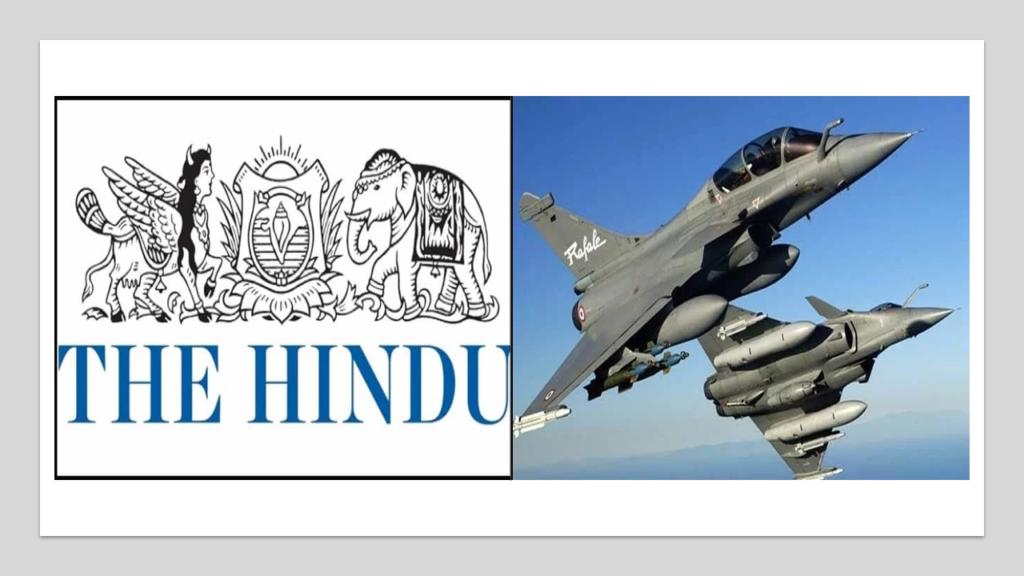The phrase, ‘A lie spoken a hundred times is perceived as truth’ sums up the Nazi-style propaganda going on around the Rafale deal. Today, The Hindu (or anti-Hindu?) published an article saying that the Modi government ended up paying 41% more per aircraft than the UPA did in its deal. The Hindu is indirectly hinting that since Rafale jets are costlier, it’s a scam. We need to put things into perspective.
Development Costs
The Rafale deal was to have thirteen India specific enhancements and Dassault put forth a fixed cost of 1.4 billion Euros in 2007 in order to invest in research so it might cater to India’s requirements. In the NDA deal the price was negotiated and reduced to 1.3 billion Euros. Note that the cost is fixed, as in the development cost doesn’t change with the number of aircrafts you purchase. Thus, when India decided to purchase 36 aircrafts instead of 126, the development cost was borne by 36 aircrafts, which increased the cost per aircraft.
Misleading Headline
True to its obsession with creating a sensation, The Hindu’s news headline proclaimed that “Modi’s Decision to buy 36 Rafales shot the price of each jet up by 41%”. This calculation includes development costs as mentioned above. Now, it is common sense that when one calculates differences in prices, the prices should be of the same year. Take the UPA deal’s price of 2007 and the NDA deal’s price of 2015, disregarding the time value of money completely, one can calculate price escalation from 2007 to 2015, and then calculate the difference, the NDA deal turns out to be only 14% costlier. And guess what, the article itself mentions and yet its editor chooses to sensationalize over sticking to facts.
Then why 36 aircrafts?
Now one may argue that if the fixed cost was to be borne, then why did the government not buy 126 jets to distribute that cost better? The answer can be seen from Raksha Mantri Nirmala Sitaraman’s statement in the Parliament. Any kind of emergency purchase consists of 2 squadrons (1 squadron has 18 aircrafts). Thus, given the precarious condition of the IAF which had only 32 squadrons left, an urgent filing up of the squadrons was necessary. The NDA had no choice but to go ahead with a purchase of 2 squadrons even if it meant paying a larger price. Perhaps PM Modi understands that national security takes precedence over squandering time and avoiding a 14% hike in price.
Secondly, the 1.4 billion Euro development costs were quoted in the UPA deal in 2009 as well. Time value of money works here too. Dassault could have increased the development costs in 2015. But rather than increase it, the NDA negotiated and had it reduced to 1.3 billion Euros. The government clearly tried the best it could.
Thirdly, a procedure was followed in accepting this high development cost and the Hindu mentions it. The Indian Negotiating Team (INT) voted by a 4-3 majority that the 1.3 billion Euro cost in 2015 was better than the 1.4 billion Euro cost of the 2009 deal. This point was made in front of the Defence Acquisition Council (DAC) as well as the Cabinet Committee on Security (CCS) who ratified it.
Then why not buy from Eurofighter?
The Hindu seems to be particularly enthusiastic about a deal given by another defence manufacturing consortium called Eurofighter Typhoon Consortium. This manufacturer lost out in the bidding in 2011 since Dassault quoted lower prices, but looking at the stalled negotiations conducted during UPA times, in 2014, Eurofighter made an offer of selling 126 jets at a price 20% lower than Dassault. The Hindu seems to be questioning why the government didn’t accept that offer.
The answer was given by The Hindu itself. Eurofighter proposed its new deal in 2014 when the bidding had already been closed in 2011. The Hindu says it would be a violation of Defence Procurement Policy and CVC rules to consider bids that come after the deadline.
Secondly, had the government accepted Eurofighter’s offer, Prashant Bhushan and others would surely file PILs in courts. The entire Rafale case in the Supreme Court rested on the contention that the NDA didn’t follow proper procedure under Defence Procurement Policy and it seems unlikely that the SC would consider it legitimate for the government to accept Eurofighter’s proposal. The Hindu would proudly proclaim that a scam has been proven in the Rafale Deal because a totally new dealer like Eurofighter was brought in if events were to take this turn as well.
All Procedures Followed
The Hindu rues that Manohar Parrikar headed the Defence Acquisition Council (DAC) and didn’t take any strong decisions but instead passed the buck to the Cabinet Committee on Security (CCS). One might ask if there is any procedure that requires the DAC to make decisions and not pass them on to the CCS. Also, the 4-3 majority vote cast in the Indian Negotiating Team for accepting the 1.3 billion development cost mentioned above also shows that proper procedure was followed.
All in all, the Rafale deal is a step in the right direction, a much needed lease of life for the Indian Air Force. It is sheer foolishness to insinuate that it is in any way similar to the Bofors deal. It seems that as elections approach, the fake news factory is running to full capacity and its no surprise that journalists like N Ram choose to peddle lies about Rafale. I find it disappointing to see an institution like the Hindu, which was started in 1878 in order to aid India in her struggle for freedom against British rule, act as if its current motto were to achieve Freedom From Facts!
